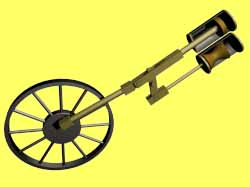|
|
|
|
|
|
|
Victorians The Victorian period was a time when the British Empire was the greatest and the richest in the world. It was a time of progress in technology and industry with many exiting new inventions being produced. It was also a time when people were regularly dying of poor working and living conditions, and diseases such as cholera from polluted water in the cities. |
| Queen Victoria | |
|
Victoria was born in Kensington Palace in London on 24th May 1819. She was the daughter of Edward, the Duke of Kent and Princess Victoria of Saxe-Coburg. Edward was the fourth son of George III and he died when Victorian was eight months old. Victoria became heir to the throne because her three uncles: George IV, Frederick Duke of York, and William IV had no surviving children. She became Queen, at the age of 18, when William IV died in 1837. |
|
|
In 1840 Victoria married her cousin, Prince Albert of Saxe-Coburg in Germany. They had nine children before he died, aged 42, in 1861. After Albert died Victoria wore black for the rest of her life. Victoria died on 22 January 1901 at Osborne House on the Isle of Wight, after a reign that lasted almost 64 years, the longest in British history |
|
| Empire | |
|
During the
Victorian period the British Empire was at its largest. Queen Victoria was
pronounced 'Empress of India' and lands on the other side of the world like
Australia and New Zealand were being made part of the Empire. It has been estimated that the British Empire covered one quarter of the worlds land surface. |
|
|
|
Flag of the United Kingdom of Great Britain and Ireland |
|
But all was not well: There was a mutiny in India that was ruthlessly put down by the Army and there was a war in South Africa with the Zulus and then the Boers. The Zulus defeated a large British army at a place called Ishandlwana but were repulsed at Rorke's drift by a small contingent of troops mainly from the 24th (2nd Warwickshire) Regiment of Foot. |
|
 |
|
| St. George's Flag | St. Andrew's Flag | St. Patrick's Flag | Union Flag of England and Scotland |
| Railways | |||
|
During the Victorian period the railway network evolved to become a dominant factor in the transport system of the United Kingdom and had a widespread impact on the culture, economy, society and landscape of the country. In 1804 Richard Trevithick built a steam locomotive for his iron works at Penydarren in Wales. It was very unreliable but it could pull ten tonnes of iron. |
 |
||
|
|
Click to see an animation of a simple steam engine |
|
|
|
In 1825 the Stockton to Darlington rail line was opened. There were two locomotives, the "Experiment" and "No 1", that pulled 21 coal wagons 25 miles at 8 miles per hour. The line quickly became profitable and soon passengers began to be carried. |
|||
|
The Rocket |
In 1829 the Rainhill Trials took place. The train that won was the "Rocket" built by George Stephenson. The "Rocket" travelled at 46 kph (30 mph). |
|
In 1830 the Liverpool to Manchester railway opened and the Age of Railways began. By 1900 there were over 22,000 miles of rail track in Britain. |
|
| Great Exhibition |
|
The Great Exhibition was conceived by prince Albert, the husband of Queen Victoria. It was held in Hyde Park in London in the Crystal Palace, a building specially constructed for the event. The event attracted over 6,200,000 visitors who viewed more than 13,000 exhibits that were on display from all over the world. |
| Crimean War |
| Between the years 1854 to 1856, Britain fought its only European war from the end of the Napoleonic wars in 1815 and the start of the First World War in 1914. |
|
The war started as a disagreement
between Russian Orthodox monks and French Catholics over who had rights at the
holy Places in Jerusalem and Nazareth. Tsar Nicholas I of Russia moved troops
into Wallachia and Moldavia (modern Rumania), which was part of the Ottoman
Turkish empire. His fleet then destroyed a Turkish flotilla off Sinope in the
Black Sea.
The British were already suspicious of the Russian intention towards India and were unwilling to accept Russian domination of Constantinople and the Black Sea. The French allied themselves with Britain and both counties moved troops against the Russians in Wallachia and Moldavia, driving them out by the summer of 1854. |
|
Then it was decided that the
large naval base at Sevastopol in the Crimea was a threat to future peace
and a combined French and British force was sent there to destroy it. Finally after several battles at the river Alma, Balaclava and Inkerman Sevastopol fell and the war was brought to an end by the Peace of Paris in 1856. |
The Charge of the Light Brigade
by Alfred, Lord Tennyson |
| The war cost a lot of lives, more due to bad conditions and disease than actual fighting. One of the most notable figures of the period was Florence Nightingale who revolutionised the treatment given to patients at the military hospital at Scutari, reducing the death rate by over a half. | |